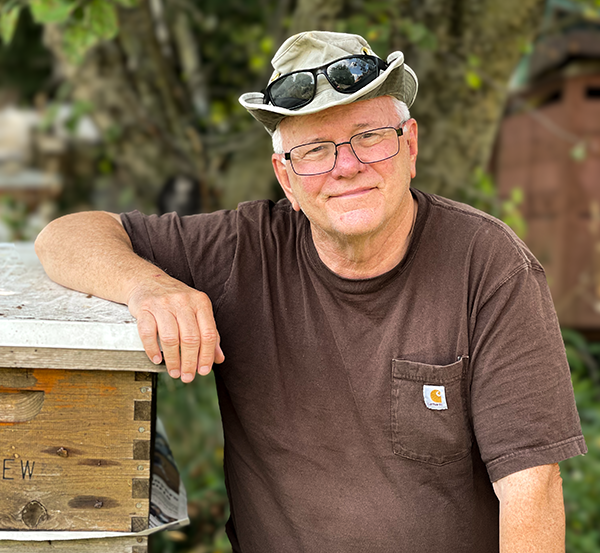A common procedure, but without clearly defined boundaries.
By: James E. Tew
“Hey, just combine them”
Combining colonies is a common procedure. As beekeepers, we do it all the time. Yes, we do it and we freely tell other beekeepers to do it. “Hey, just combine them.” Recently, in another piece I was writing, I made the following comment, “Any colonies that don’t take the new queens (or are weak) should probably be combined with another colony.” I was writing this statement in support of Fall Management protocols. As is so often the case, I made no recommendations as to how small the sickly “combinee” should be, nor did I make any reference to the population size and condition of the larger colony, the “combiner.” This fluidity is what I am exploring in this rambling article. Combining colonies is a very relaxed management recommendation.
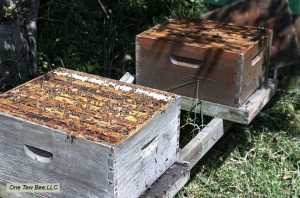
Figure 1. The upper, weaker colony will be combined with the lower, stronger colony.
Not a natural procedure
Wild colonies die all the time. (At this point, I tried to find a generalized citation for just how often wild nests die. One was not readily available. Imidacloprids, water availability, and varroa predation were some of the reasons that feral colonies died. So, I will just leave it at, “Wild colonies die all the time.”) Colonies do not combine in nature; the weak colonies just die – or at least languish until they do die. (If this were a live presentation, I would expect a competent questioner to ask, “Do bees from dying colonies ever drift to more populous colonies?” That would be a good question, and I would not have a ready answer. I would most likely respond, “Probably, but I don’t know for sure.”) Robbing from more populous colonies is normally the coup de grâce for undersized colonies.
In beekeeping manipulations, we do these oddities all the time. Beekeepers collectively call these manipulations “colony management.” A wild colony does not go searching for a new queen outside its own colony. They always grow their own from their own brood.
In our human world, beekeepers show up in the bee yard with a caged queen – that has never been part of the colony to which she is about to be “introduced.” We then try to coerce the colony to accept this interloper. Or could I say be that the foreign queen is to be “combined” with the queenless colony? After the required introduction time, the queen is amalgamated (or combined) with the colony. The acceptance of a foreign queen is as unnatural as two feral, weakened colonies deciding to combine their meager resources, and become one. That’s not going to happen. They are both going to die before Winter’s end.
Beekeepers, when I think about it, bee management, in general, is just a long list of “oddities” that we do for (or to) our bees that they would never do for (or to) themselves. For example, wild colonies do not live in apiaries (groups), they don’t swap or share brood, they don’t add more space when their cavity is filled (supering) and they are not crazy about straight, standardized combs. So, no – combining colonies is not something that happens in nature, but it is something that happens in bee management – and it’s an old, useful procedure.
“Hey, just combine them” – again
Think about it. What are we actually accomplishing when we combine a weak colony with a stronger colony? Bottom line – we are giving the stronger colony the problem that we probably caused in the first place.
When considering laying workers, let’s look at this situation from the perspective of the stronger colony. Out of the clear, blue sky, in ways that would never happen in nature, a functional and staid colony suddenly has ten frames added to it – with some of the frames containing laying worker brood, and supported by a cadre of old, physically depleted workers. Within the hive, I have no idea how the bees sort this mess out, but I do have some guesses.
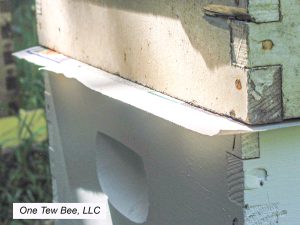
Figure 2. A newspaper sheet used to combine two colonies.
A series of assumptions
In ways unknown to me, I assume that healthy worker bees, from the receiving colony, perceive the laying worker eggs and brood and either eat or otherwise remove the haploid brood from the combined colony nest. I also assume that the adult laying workers most likely die of old age or from internal colony abuse. Until their death, any eggs that they may have continued to lay, will be – once again – destroyed by healthy worker bees. The undersized drones really have very little hope of any kind of success (I assume). In general, the undersized drones are just going to die. (In past articles in which I discussed laying
workers, I postulated that these puny drones were the last effort of the laying worker colony
to dispense its genetic strain into the greater gene pool. Regardless, these undersized drones – last effort or not – do not stand much of a chance for success.)
So yes, as bee colony managers, we all know that a “suitably strong” combiner colony can contain and clean up the failed situation. But… was the receiver colony improved or advanced by having to spend its time and energy getting this situation under control? I think not.
I speculate that two or three things happened in this laying worker scenario: (1) We beekeepers did not have to watch the bees from the smaller colony die, (2) we got our deep hive body back with ten frames all nicely cleared out and ready for reuse, and (3) the stronger colony protected the laying worker combs from wax moths. I speculate that rarely is the stronger colony made even stronger by the addition of a laying worker colony or any weakened colony for that matter.
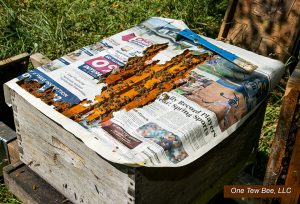
Figure 3. Newsprint being removed 24 hours later.
What caused the weakness?
It is important to the beekeeper manager that they know the reason for the smaller colony weakness. For instance, during this past Spring season, I had a beautiful colony that seemingly would not stop swarming. While I got two swarms from that colony, I don’t know how many others got away. But by the time the swarming impulse waned, the once-beautiful colony was only a weakened shadow of its former self. Presently, I have no plans for combining this colony with another, but I know why this unit is now a smaller colony.
Queens age and their output declines. The season passes and worker population declines some. There are many reasons why a colony will be less than what it was just a few months ago. Don’t feel pressure to combine just because the colony’s population fluctuates some.
Please consider this – Important
Do not combine colonies that are diseased. Be able to recognize American foulbrood (AFB). Isn’t it ironic that beekeeper transmission is the main way AFB spreads? Thankfully, AFB is reasonably rare, but stunningly persistent. Make a major effort not to spread this disease – or any other – within your bee yard. If you are uncertain about any disease or another in-hive pest, gather more information or get the opinion of others.
Though off the subject, a comment on making splits is pertinent at this point. Do not make splits or take bees for colony increase from colonies that are diseased. Both combining colonies and splitting colonies are two common times that beekeepers can spread diseases in their apiary.
The timing
If you are combining colonies, the chances are excellent that a major nectar (or pollen flow) is not ongoing. Before a flow begins and during a flow, beekeepers would be in the “give the weak colony a chance” mode. As the food-gathering time passes and it becomes clearer that the colony is not going to thrive, then the concept of combining them with another colony becomes the standard option. So, what else is timely at this point? Robbing behavior.
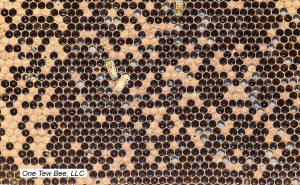
Figure 4. A colony with a brood pattern like this should be destroyed – not combined. This frame has American foulbrood.
In previous articles, I have seemingly had robbing behavior epiphanies, and I waxed long and then even longer in some of my earlier articles3. But based on my thoughts on robbing, if there is no flow ongoing, I can assure you that foragers from large colonies are not just sitting in the hive awaiting the day when once again flowers abound. Nope – they will be nosing around neighboring colonies checking their defenses.
At this point, let’s say that you begin the combining process. No flow is occurring, and you are opening two colonies – one very weak – and causing defensive confusion in both colonies. This situation would entice robbers to check out the confusion at the combined colonies. In the bright light of harsh reality, many times we would not be heartbroken to have the smaller colony robbed and killed. Its fate was sealed anyway, but we most likely did not want the healthier of the pair to also be attacked. That’s the colony that deserves our worry.
What to do? In a perfect world, we would move the colonies to a different yard. Then there is the reality of moving two colonies at least three miles away and the related problems that are associated with moving colonies. That is a different article. All this effort – all of this typing – all of this thought – is for a small bee colony that is actually nearly dead already. It’s what we do. We’re bee keepers, not bee killers.
Colony combining techniques
Shake the bees out of the equipment
The combining technique typically varies with the population of remaining bees in the dying colony. If there are only a few – maybe 200 to 300 bees – many beekeepers just shake them out of the equipment near another colony. They may or may not find their way into the nearby colony. We knew that would happen when we used this technique.
Newsprint sheet barrier
If – for whatever reason – there are more bees – maybe a thousand or more – a simple sheet of newspaper atop the stronger colony of the two is enough of a confusion barrier to seemingly distract the bees as they remove it from the combined hives. A few slits or a few punched holes through the newsprint is supposed to inspire the bees to remove it more quickly. The weaker colony is put on top of the lower, stronger colony. As per the title of this article, this is not a precise procedure.
A puzzlement… I wonder what happens between two opposing bees as they penetrate the newspaper and greet one another for the first time. Do they both smell and taste like newsprint? Do some newly introduced bees actually confront each other in an aggressive manner and beekeepers just do not see it? Rather, are the bees being combined defeated and placid? It does appear, that as newspaper is removed, the bees begin to amicably coexist. It’s a puzzlement to me that a simple piece of paper is enough to alter fundamental innate bee behavior. However, it appears that it does.
Smoke
Use smoke on both colonies. After removing the queen, if she is still present, shake the bees from the weaker colony onto the open top bars of the larger colony. Use appropriate smoke the entire time. Close the colony and remove the now empty equipment from the area. Then, hope for the best.
Sugar syrup
Use thin scented sugar syrup in the same manner as smoke. Spritz both colonies. Remove the queen from the weaker colony and while spritzing the scene, shake the combined bees onto the top bars of the stronger colony. Then, maybe another spray or two and close the colony up. Again, it is important to remove the empty equipment from the area.
Confinement
Using a package bee funnel, shake equal quantities of bees from both colonies into a package cage. Feed the combined bees enough to keep them alive for a few hours. Shake the bees back onto the top bars of the stronger parent colony. What you were trying to accomplish with this procedure was to have the foreign bees have the odor of the colony with which they were being combined.
When releasing the bees, maybe use a bit of smoke or some sugar syrup, but this step is not required. Close them up, and again, hope for a bit of good luck. To me, this process seems like a lot of work, but the procedure is in your management tool box if the need arises.
Everything is a variable
When using this concept of uniting colonies, there are numerous variables. For instance, how many small colonies do you have to combine? Are they tiny colonies or do they have respectable populations? Maybe you raised some queens, and you now have depleted nucs that need to be emptied. Maybe you picked up small swarms that did not grow to a suitable size. I’m speculating. I really don’t know why you have these small colonies, but you do have them.
Experienced beekeepers have indicated that they like to leave their good colonies alone and only perform combining procedures using “average” colonies as the receiving colony. Possibly, the average colony is helped by the additional bees. The management point is – do not disrupt your best colonies with these combination procedures. Also important, do not take excessive amounts of brood from good colonies to subsize combined colonies. Always remember that you are essentially working with dying bees.
One quirk without a category in this article
There is a situation when bee colonies – in a way – do combine themselves. Many years ago, when the Africanized honey bees (AHB) invasion was a major beekeeping issue, scientists reported that small swarms – headed either by mated or unmated AHB queens – would alite on a bee hive and invade the European stock within the hive. The invading bees would usurp the colony’s European queen and take over the colony. Were these colonies combining or were the European colonies simply being invaded? I am not aware of any recent reports of this happening, but just so you know…
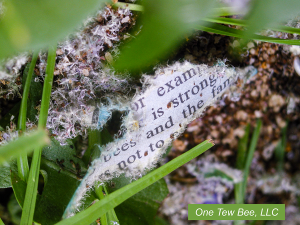
Figure 5. Frayed pieces of newspaper in front of colonies being combined.
In most instances
After thinking and writing on this subject, I sense that in most instances, when I have combined colonies, I was really just trying to get rid of the aged bees and get my empty equipment back. Additionally, I was trying to keep wax moths from overtaking the unprotected combs. I can’t think of a single instance when I ever combined a colony and then truly believed that I had a stronger colony because of the combination procedure.
This process seems to be a very useful way to eliminate bee colonies that simply did not make the grade. When keeping bees, you win some and you lose some. Combining bee colonies is simply a management tool. Use it when you need it. The bees will sort things out.
Dr. James E. Tew
Emeritus Faculty, Entomology
The Ohio State University
tewbee2@gmail.com
 Co-Host, Honey Bee Obscura Podcast
Co-Host, Honey Bee Obscura Podcast
www.honeybeeobscura.com






